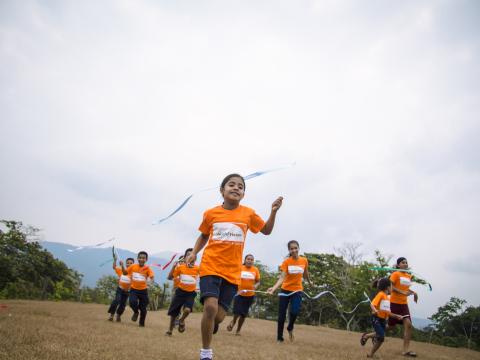I have a dream...Latin America: a region free of violence

By David Munoz | Regional Communications Manager | World Vision Latin America and the Caribbean Regional Office
Children in Latin America like children all over the world have lots of dreams. From toys they just got in Christmas, more time to spend with friends, etc., to other dreams made on a different context where they consider their current environment, but over all their well-being.
“I still have a dream,” it’s a repeatedly phrase by all children in Latin America whom refuse to stop dreaming, but where the high levels of violence steals most of their dreams; “My dream for the place I live is that nothing bad happens, I want good things to happen,” says Tadid, eight years old, from Dominican Republic.
In the midst of a region that suffers from violence towards children, adolescents and women, either by cultural practices or social injustice, World Vision decides to focus its efforts to fulfill the dreams of all children. “All children must be able to accomplish their dreams,” mentioned Amada Rives, Advocacy & Communications Director for LACRO.
But, how bad is violence? Violence against children goes unreported in countries like Mexico, Colombia, Guatemala, Honduras, El Salvador and the Dominican Republic up to an 88% (1) of the cases; parents are “allowed” by culture to hit their children ending in some cases in serious injuries that require medical intervention. Citizens in countries like Honduras, Peru and Bolivia perceive that “their government are unwilling to take action,” while there is an urgent need of collaboration with non-profits organizations and it’s perceived that NGO and churches have an important role to play in preventing and tackling down violence.
Maras (gangs) keep fighting for territory in Central America (Honduras, Guatemala and El Salvador) and harming or threatening youth that do not agree to join their gangs; thousands of children keep fleeing to the U.S. border but the scenario in Mexican territory is not secure for them. In the last six years, 47,000 migrants have been murdered in Mexican territory by the organized crime.
Only in Mexico, 10.7 million of homes, at least one member of the family have been victim of a crime or violence (data source INEGI –National Institute of Statistics, Geography and Informatics, 2014) — this represents 40% of the total of Mexican families.
“Violence has growth at disproportionate levels affecting mostly the new generations of children and youth in Latin America and causing severe collateral damages into families, communities and countries. But it’s also them who are seeking to fulfill their dreams, for a change in their lives and ways to overcome violence before that violence overcomes them,” added Mrs. Rives.
This is where the regional initiatives from World Vision in Latin America connect with the children in a single cause: “A region free of violence against children” which aims to contribute to build a continent free of violence through prevention and protection efforts and by addressing abuse, neglect, exploitation, and all other forms of violence against children; the campaign aims to transform the paradigm of relationships within a culture of peace, overcoming poverty and equipping the new generations to face the challenges that Latin America currently has: “World Vision has the unique opportunity to bring everyone together; working with the children, their families, communities, churches, government toward ensuring sustained well-being of children, so that they can grow in safe environment and fully develop their God-given potential” says Michele Gonzalez, WVUS Senior Regional Advisor for the Latin America and the Caribbean.
All 14 national offices in the region will implement this integrated campaign, “A region free of violence” in their current programs and will work with children and their parents on conflict resolution, the promotion of a culture of peace at community level, working with parents on how to raise children with love; joining efforts with churches in promoting hope among youth at-risk in Central America, especially thru education and economic development opportunities, and many other efforts.
2015 is the year that “A region free of violence” will interact within 14 countries in the region through media campaigns, workshops and alliances, and with government and non-government organizations in order to build a safer continent.
SOURCE:
1 Fearing Wrong, Why what doesn’t scare us should, 2015 / page 35